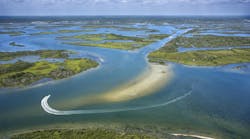About the author: Eric Keith is business development manager for Hach Environmental. Keith can be reached at 970.669.3050 or by e-mail at [email protected].
Municipal water quality managers recognize the need for data that can be used to monitor and assess the impact of urbanization on the condition of natural watersheds. Storm events, in conjunction with the alteration of native landscape, building of roads and overuse of fertilizer, can contribute to excess nutrients, sediment and other pollutants in environmentally significant watersheds. Such pollutants often make their way downstream through natural watersheds and detrimentally impact the quality of freshwater bodies.
For the city of Lake Oswego, Ore., quantifying the effects of watershed urbanization on Oswego Lake—an important local freshwater reservoir—has been instrumental for proving the future success of upstream pollution prevention programs. The major challenge for Lake Oswego was planning compact and unobtrusive water quality monitoring stations that leave a small footprint and have low impact to the surrounding natural environment. In addition, delivering data in a repeatable, low-cost way was deemed necessary for the long-term success of the monitoring program.
Station Supplies
David Gilbey, water quality program coordinator for the city of Lake Oswego, chose two local tributaries as initial sites for a stream discharge gauging network for the city’s supplemental environmental program. In part, this program is designed to characterize the effect of storm water runoff through two specific watersheds. The two tributaries chosen were Springbrook and Lost Dog creeks, which most influence Oswego Lake.
Hach Environmental, Loveland, Colo., supplied the instruments for both water quality stations. Station instrumentation consisted of a Hydrolab MS5 multiparameter water quality instrument, an OTT compact bubble sensor (level meter) and an OTT LogoSens2 station manager (SDI-12 logger).
Each station measures and records pH, temperature, dissolved oxygen, specific conductance, turbidity and water level. Recorded data is regularly accessed from a local city of Lake Oswego office via a cellular-based Internet connection that links the water quality stations to a PC. This setup not only provides instant access to real-time water quality data but also eliminates the costs of routine travel to remote sites for data collection. Solar panels were installed to provide convenient year-round power without the addition of AC power.
Monitoring Outcome
Springbrook and Lost Dog creeks are now monitored continuously to better quantify any potential watershed impacts. Data collected from these sites can be used in near-real time to calculate pollutant loading and review potential illicit discharges from upstream. Lessons learned from the implementation and monitoring of these sites will aid in the improvement of data gathering and expansion of the area’s pollution prevention program.
Download: Here

